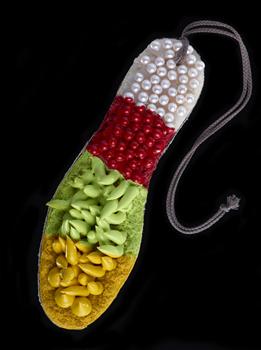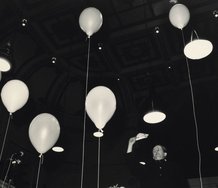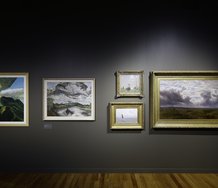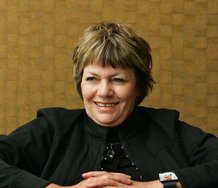Peter Ireland – 26 June, 2011
'Collecting Contemporary' is on for a whole year, and there seems little in the exhibition's labelling or on the museum's website to indicate whether or not a rolling replacement policy re the contents is involved. If not, it's going to be a very tedious twelve months for regular visitors, and gives rise to the suggestion that the reigning minimalism may also extend to curator enterprise.
The Museum’s website states: “Collecting Contemporary presents a wide variety of New Zealand art and objects acquired by Te Papa between 2006 and 2011”. Occupying the long Boulevard gallery on Level 5 it’s a very austerely mounted show, the cool minimalism of many of the works paralleled by the cool, minimalist presentation. There couldn’t be a greater contrast between this exhibition and the jumble of E Tu Ake: standing strong one level down. A timely aside: in his 2007 book Exhibiting Maori: a history of colonial cultures of display, Conal McCarthy made great symbolic mileage out of the circumstance of the former National Art Gallery being on the floor above the former National Museum on the old Buckle Street site. Pakeha art on top of Maori taonga, see. Well, what’s changed? The two institutions may have amalgamated and the site moved but this apparently colonial signifier still reigns architecturally. We eagerly await the next chapter in this continuing critique.
One of the planks of the Te Papa project was that the notion of the “permanent exhibition” would be consigned to the dustbin of history. This brave new world would be fleeter of foot both in responding to contemporary needs and maintaining visitor numbers. Well, in the dozen years since the new museum opened, this hasn’t been the case outside of touring shows. The long-running Art of the Nation exhibition is a more permanent show than anything the old and strategically maligned National Art Gallery ever managed in the last thirty years of its life. Indeed, that relatively poorly-staffed and funded institution ran a programme at Shed 11 livelier and more international than anything Te Papa’s been able to present despite greater space, many more staff and greatly increased funding. Younger readers interested in photography may find it hard it believe that early in 1988 the NAG had, simultaneously, a touring show of Rodchenko’s photography from Oxford’s Museum of Modern Art, plus two large in-house curated shows: Richard Misrach’s Desert Cantos and, at Shed 11, a major survey of Cindy Sherman’s work, one of the first such outside of the continental United States. Over the past two decades our access to the world has expanded hugely, but contemporaneously at our national museum that access has actually been shrinking.
Collecting Contemporary is on for a whole year, and there seems little in the exhibition’s labelling or on the museum’s website to indicate whether or not a rolling replacement policy re the contents is involved. (Although, apparently, a statement to that effect was made at the show’s opening.) If not, it’s going to be a very tedious twelve months for regular visitors, and gives rise to the suggestion that the reigning minimalism may also extend to curator enterprise. “Bang for buck” may be a rather crude notion in the rarified world of museum curatorship, but at a time of economic austerity it might at least be a consideration for the politically aware. Even though the show’s up on Level 5, the space is still closer to having its feet on the ground than its head in the clouds.
Of course it’s always good to see what Te Papa’s been acquiring, even if it may be the tip of a more interesting iceberg. But given the minimalist feel of the selection and the minimal labelling it’s hard to get a fix on what the show’s about beyond a general showcasing. One thing is certain though, it’s a show for those in the know. Now come on guys, it’s only a few years since various Te Papa apologists were accusing any critic of the dreaded “elitism” and here we have a show in the museum’s major exhibition space for a whole year that is so riven by assumptions of superiority as to make the term “elitism” almost redundant in its descriptive inadequacy.
Another plank of the Te Papa project was a commitment to give the objects in its collection a context when exhibited and not just treat them as singular cultural trophies. Hence the famous mismatch of the McCahon with the fridge in one of its opening shows. Sometimes you get the feeling that the museum’s like a car out of control, slewing from one side of the road to the other as if its mission were to imitate a stock car event rather than calmly complete a useful journey somewhere. If Collecting Contemporary’s any indication, the policy of context seems to have gone down the tube.
One of the braver planks of the Te Papa project was its privileging of “concept developers” over mere “curators” in the construction of exhibitions, a change of focus partly out of the text-ridden ‘80s where the idea was valued over the visual. Despite its impressive intellectual base it was a new form of iconoclasm. As Braque once admitted of painting; it’s “finished when it has effaced the idea. The idea is the launching cradle of the painting” - something that curators know but concept developers clearly have problems with. Their assumption seems to be - as demonstrated by E Tu Ake - if it’s a good or worthy idea, a convincing or worthy show will naturally result. Well, no. Just how many more exhibitions is Te Papa going to grind out before they geddit?
The ‘80s was the decade of the corporate business model too, and the construct of Te Papa still reflects this mentality. While it may give the institution the kind of political heft useful when it comes to the annual divvying up of the consolidated fund, the downsides are (a) a preoccupation with image and (b) risk-averse bureaucratic structures depending on committees, with processes so convoluted as to move more slowly than ice at Franz Josef. This environment is unlikely to encourage initiative or come up with surprising and stimulating exhibitions. You long for someone there to take a punt and all we get is box-ticking.
The Te Papa project positioned itself as being in the vanguard of 21st century museums. Maybe the rest of the world is out of step, but in the past two decades all the books to appear featuring new and innovative museums have - perhaps for their own pathetic reasons - overlooked the battleship-grey pile on Wellington’s waterfront. Hello? The proof of the pudding, as they say, is in the eating, and the taste sensation after a dozen years of performance is - to mix metaphors slightly - hardly the fizz of champagne.
There’s no doubt that Te Papa’s increased resources have lead to some wonderfully energetic and wise acquisitions, to vastly improved storage conditions, awesomely professional conservation projects and an increasingly enterprising publishing programme, but when it comes to exhibitions their emblem just has to be the camel - a horse designed by a committee. It appears that the newish CEO is in the process of establishing a “Revisioning committee” - the very idea of which is a mixture of hope and despair - and maybe something will come of it. The fact it’s yet another committee is pretty dispiriting. Does the corporate model automatically exclude an individual acting decisively? Maybe that’s why in an older model the guy in charge was called a Director and now it’s a Chief Executive. The difference in the monikers isn’t just symbolic.
This institutional quagmire has implications, and not just for exhibitions. Two texts in association with Collecting Contemporary hint at what they might be. Let’s return to that crisp descriptive sentence on the Museum’s website quoted at the beginning here: “Collecting Contemporary presents a wide variety of art and objects acquired by Te Papa between 2006 and the present”. Art and objects. Presumably the latter refers to the ceramics and jewelry included in the show. So, is Te Papa hesitating to refer to, say, Richard Parker, Martin Poppelwell, Octavia Cook and Warwick Freeman as “artists”? If one follows through logically, these second-class citizens must rest easy with the designation “object-makers”. We’re living - supposedly - in a Pacific culture where traditions of adornment, weaving and other “crafts” have a longer and more honorable history than painting. If Te Papa’s really in the vanguard and really committed to this culture here and now - not just for “branding” reasons - then why does it persist in making distinctions between “artists” and “object-makers” that were becoming redundant in the 1970s. OMG, it’s 2011!
The exhibition includes three photographers: Ben Cauchi, Ann Shelton and Gavin Hipkins. Cauchi’s represented by two ambrotypes and a tintype, Shelton by one of her mirror-image dyptiches (called a “doublet” on the label: isn’t that a medieval guy’s tight shirt?) relating to the infamous Parker/Hulme crime scene in Christchurch’s Victoria Park, and Hipkins by a twelve-part sequence entitled The Terrace. There’s a photographic component of Maddie Leach’s Ice Rink in the Museum on show too, but it’s a piece essentially conceptual rather than specifically photographic.
Some larger questions about collecting are implied in the general label about photography in Collecting Contemporary, and it needs to be quoted in full:
New Zealand public galleries and museums did not begin collecting photography as art until the late 1970s. Private collectors slowly followed suit, and today photography occupies a small but significant part of the art market. These developments were partly the result of photographers themselves campaigning for the acceptance of photography as a creative medium in its own right with its own distinct aesthetic history.
Today, art in general has become less medium-oriented, with artists often using materials appropriate to their purpose at the time. Many artists use photography but do not see themselves as photographers. But those who identify themselves primarily as photographers clearly draw on the artistic traditions of the medium in their practice. Te Papa actively acquires photographs that fit within the context of contemporary New Zealand art, as well as collecting a broad range of historical photography.
Firstly, it’s odd that the only wider context mentioned for the medium is the art market. The art environment, perhaps, in which the art market plays a small - but necessarily noisy - part, and the part photography plays there is not only small but tiny. What evidence there might be for that occupying “a significant part” is not easy to marshall. The facts are, simply, otherwise.
Secondly, the second paragraph seems to be making the case Warwick Brown made in the Introduction to his 2009 book Seen This Century where he stated “As for photography generally, I think it has most relevance when it is integrated into an artist’s wider practice”. Where freedom of speech is valued such expressions of individual opinion, however antique, need to be tolerated. But when a national museum starts voicing the same neanderthal notions it’s time to don some boxing gloves. The label’s final paragraph makes a distinction between “contemporary” and “historical”. The implication seems to be that there are some hot young artists using photography in their work that needs to be acquired now, while some boring old guys, drawing “on the artistic traditions of the medium in their practice”, will have to wait til they’re history before Te Papa’s gonna buy their stuff.
An instance: take John Miller. An apparently very conventional documentary photographer who, for the past 45 years and without any “artistic” pretensions, has doggedly charted practically every significant event in our recent bi-cultural history. A small show of it at the Govett-Brewster a couple of years ago was a revelation. Not just for the subject matter or the evidence of his extraordinary instinct and sense of timing, but for its unvarying formal distinction that in the circumstances of its creation is little less than miraculous. That such an artist is not perceived as fitting “within the context of contemporary New Zealand art” is not a question of any Miller shortcoming, it’s a question of blinkered Te Papa policy, stranded in the avant-gardism of late Modernism and even earlier constructions of hierarchies in art. It may be that when what moves and distinguishes this particular culture is totted up, Miller’s achievement will be assessed as greater than, say, messers Hipkins, Shelton and Cauchi put together.
Peter Ireland
Recent Comments
Kim Finnarty
Love your work. I was just thinking of Wedde and the fridge the morning before I read this; with curators ...

 Advertising in this column
Advertising in this column Two Rooms presents a program of residencies and projects
Two Rooms presents a program of residencies and projects



This Discussion has 1 comment.
Comment
Kim Finnarty, 9:05 p.m. 30 June, 2011 #
Love your work. I was just thinking of Wedde and the fridge the morning before I read this; with curators like that who needs Philistines?
Not so sure about the architectural-colonial hierarchical hegemony, I find the art galleries on the top floor more like being in a forgotten attic; nasty corridor spaces are hardly triumphal.
As for John Miller being better than the aforementioned, how does John stack up against Marti Friedlander? Apples with apples please, even if you do suggest its all fruit salad now.
Participate
Register to Participate.
Sign in
Sign in to an existing account.